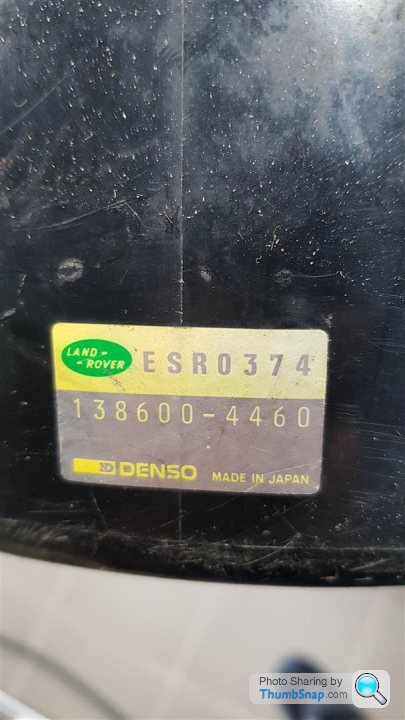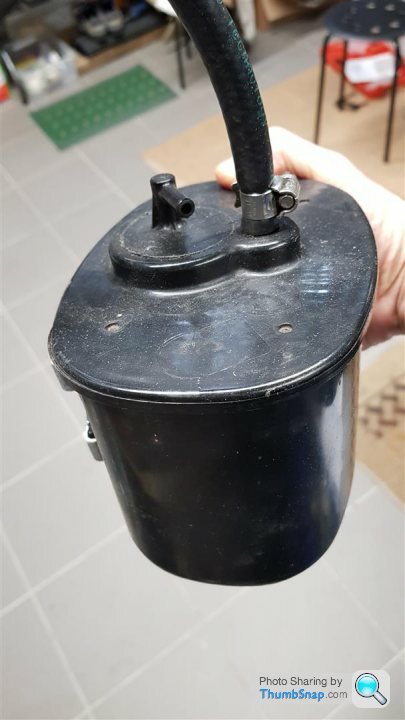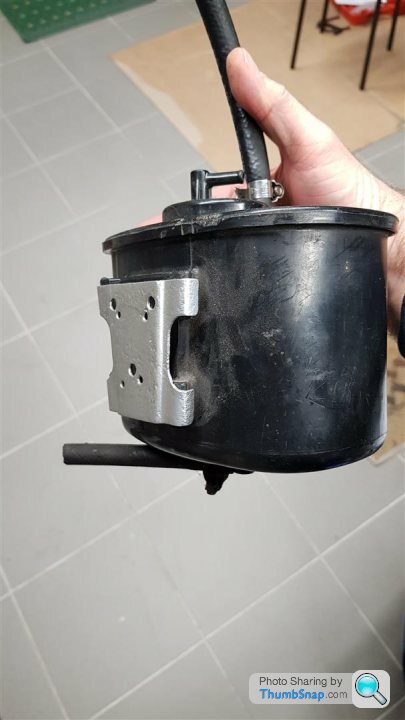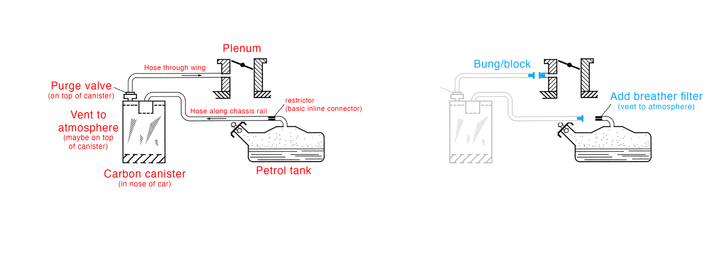Carbon canister and hoses
Discussion
Under no circumstances connect a fuel tank breather hose to inlet vacuum with no charcoal canister fitted  if the right conditions are met a full tank of fuel for example or a hot day when the fuel expands and needs to breath into the vent hose
if the right conditions are met a full tank of fuel for example or a hot day when the fuel expands and needs to breath into the vent hose  at best you are likely to fill the sump with neat fuel or worse suffer hydraulic lock
at best you are likely to fill the sump with neat fuel or worse suffer hydraulic lock  its why you have the carbon canister fitted with a purge valve that pulses open and closed and not just wide open , you either vent to atmosphere (no intake manifold connection) or leave the stock EVAP system in place , there have already been instances where owners have flooded the canister with fuel after fill up and experienced stalling issues (rich) so the thought of having no purge control and just open entry to the tank over fill makes my toes curl
its why you have the carbon canister fitted with a purge valve that pulses open and closed and not just wide open , you either vent to atmosphere (no intake manifold connection) or leave the stock EVAP system in place , there have already been instances where owners have flooded the canister with fuel after fill up and experienced stalling issues (rich) so the thought of having no purge control and just open entry to the tank over fill makes my toes curl
 if the right conditions are met a full tank of fuel for example or a hot day when the fuel expands and needs to breath into the vent hose
if the right conditions are met a full tank of fuel for example or a hot day when the fuel expands and needs to breath into the vent hose  at best you are likely to fill the sump with neat fuel or worse suffer hydraulic lock
at best you are likely to fill the sump with neat fuel or worse suffer hydraulic lock  its why you have the carbon canister fitted with a purge valve that pulses open and closed and not just wide open , you either vent to atmosphere (no intake manifold connection) or leave the stock EVAP system in place , there have already been instances where owners have flooded the canister with fuel after fill up and experienced stalling issues (rich) so the thought of having no purge control and just open entry to the tank over fill makes my toes curl
its why you have the carbon canister fitted with a purge valve that pulses open and closed and not just wide open , you either vent to atmosphere (no intake manifold connection) or leave the stock EVAP system in place , there have already been instances where owners have flooded the canister with fuel after fill up and experienced stalling issues (rich) so the thought of having no purge control and just open entry to the tank over fill makes my toes curl Edited by Sardonicus on Thursday 25th January 11:28
When you switch to an aftermarket engine management system, typically it won't offer carbon canister purge valve control, for example on a Lloyds Canems installation while the canister may still be left in place the tank fumes are ultimately allowed to vent to atmosphere at the carbon canister output that would normally go to manifold vacuum.
The gasses are no longer occasionally sucked under engine vacuum through the carbon media and inhaled by the engine as with the 14CUX setup, they are merely left to travel down the hose and eventually naturally peculate through the carbon filtration media, this process is more active in the summer when the tank and fuel gets hotter as these conditions can cause pressure to build inside the tank.
Because my tank is half the size of the original one, and 99% of the time I'm driving on LPG, and because the petrol pump is still circulating fuel to the rail and back to the tank again even when I'm on gas there's quite a bit of fuel movement in the tank which on a hot day can create pressure that pushed excessive fumes down the carbon canister hose and ultimately out to atmosphere.
This was creating quite a stink, so I simply removed the carbon canister altogether and ran the pipe to my ally induction pipe running down the N/S inner wing so the engine could still consume the fumes. I was careful not to put the hose to full manifold vacuum because as Simon quite rightly points out that would be dangerous. If you apply full and permanent manifold vacuum to the tank it would simply be be way too much suck, so you'd run the very real risk of drawing raw fuel directly out of a full tank into the engine especially if it was brim full on a hot day, this is why Land Rover only permitted vacuum to act on the carbon canister occasionally and under certain conditions.
On my setup because there's no real vacuum in the ally induction pipe, just fast passing air going into the engine, it's not only perfectly safe but it's also proven to be a 100% effective solution to fume management. Once I put the system in place the stink immediately disappeared and normal service was resumed.
The gasses are no longer occasionally sucked under engine vacuum through the carbon media and inhaled by the engine as with the 14CUX setup, they are merely left to travel down the hose and eventually naturally peculate through the carbon filtration media, this process is more active in the summer when the tank and fuel gets hotter as these conditions can cause pressure to build inside the tank.
Because my tank is half the size of the original one, and 99% of the time I'm driving on LPG, and because the petrol pump is still circulating fuel to the rail and back to the tank again even when I'm on gas there's quite a bit of fuel movement in the tank which on a hot day can create pressure that pushed excessive fumes down the carbon canister hose and ultimately out to atmosphere.
This was creating quite a stink, so I simply removed the carbon canister altogether and ran the pipe to my ally induction pipe running down the N/S inner wing so the engine could still consume the fumes. I was careful not to put the hose to full manifold vacuum because as Simon quite rightly points out that would be dangerous. If you apply full and permanent manifold vacuum to the tank it would simply be be way too much suck, so you'd run the very real risk of drawing raw fuel directly out of a full tank into the engine especially if it was brim full on a hot day, this is why Land Rover only permitted vacuum to act on the carbon canister occasionally and under certain conditions.
On my setup because there's no real vacuum in the ally induction pipe, just fast passing air going into the engine, it's not only perfectly safe but it's also proven to be a 100% effective solution to fume management. Once I put the system in place the stink immediately disappeared and normal service was resumed.
Hi guys and girls.
I need a bit of advice, I am busy rebuilding my 1993 Chimaera and did not take any photos before I took the carbon canister out. doh....
I can someone please tell me where each pipe should go. I believe that the top pipe in the picture that goes vertically is for the purge valve/Plenum. But the other two I'm not sure. One should e fresh air (in) and the other connection for vapours from the petrol tank.
Thanks,
Simon

[url] |https://thumbsnap.com/VI5ZycgA[/url
|https://thumbsnap.com/VI5ZycgA[/url

I need a bit of advice, I am busy rebuilding my 1993 Chimaera and did not take any photos before I took the carbon canister out. doh....
I can someone please tell me where each pipe should go. I believe that the top pipe in the picture that goes vertically is for the purge valve/Plenum. But the other two I'm not sure. One should e fresh air (in) and the other connection for vapours from the petrol tank.
Thanks,
Simon

[url]
 |https://thumbsnap.com/VI5ZycgA[/url
|https://thumbsnap.com/VI5ZycgA[/url
thread revival...
I have disconnected the carbon canister as an experiment with a suspected vacuum leak.
So far:
Disconnected and blocked the hose from the can to the plenum
Blocked the hose tail on the side of the plenum
Disconnected the hose along the chassis rail from the in-line connector (restrictor in this diagram) in the rear wheel arch, and blocked it
Left the hose from the tank open (with restrictor still in place) to allow the tank to breathe
I have ordered a small breather filter to connect to the restrictor, just as a precaution to keep the end clean.
I have secured all loose hoses with zip ties to stop them flopping around.
I have not disconnected the wiring to the carbon canister yet.
Does that matter?
From what I understand, the electrics here only operate a solenoid with a valve, which simply opens and the vacuum at the plenum then does the work of pulling the captured gases into the plenum. The electrics on the can itself don't have an active role in pushing gases into the plenum, right?

I have disconnected the carbon canister as an experiment with a suspected vacuum leak.
So far:
Disconnected and blocked the hose from the can to the plenum
Blocked the hose tail on the side of the plenum
Disconnected the hose along the chassis rail from the in-line connector (restrictor in this diagram) in the rear wheel arch, and blocked it
Left the hose from the tank open (with restrictor still in place) to allow the tank to breathe
I have ordered a small breather filter to connect to the restrictor, just as a precaution to keep the end clean.
I have secured all loose hoses with zip ties to stop them flopping around.
I have not disconnected the wiring to the carbon canister yet.
Does that matter?
From what I understand, the electrics here only operate a solenoid with a valve, which simply opens and the vacuum at the plenum then does the work of pulling the captured gases into the plenum. The electrics on the can itself don't have an active role in pushing gases into the plenum, right?
Once I’m happy the car doesn’t stink of fumes from the tank, I’ll disconnect fully and will get a blanking grommet for the inner wing, and will put a proper plug into the plenum.
Then the canister will find its way into my loft with the other spares and replaced bits…
Thanks for the reassurance…!
Then the canister will find its way into my loft with the other spares and replaced bits…
Thanks for the reassurance…!
Why do people remove this simple but effective system that reduces fumes from in and around the car, unless it’s knackered of course.
You have to then leave an open ended fuel tank or at the very least a filter on the end of what is now an open ended pipe. This pipe is sitting not 2 ft away from the driver.
What benefit do you gain.
You have to then leave an open ended fuel tank or at the very least a filter on the end of what is now an open ended pipe. This pipe is sitting not 2 ft away from the driver.
What benefit do you gain.
I also don't understand the desire to ditch this system. When I went to Emerald I maintained the system through the Emerald as well, using the PWM control. Was helped on here with what conditions to use to activate the valve etc.
I've seen recently people posting issues with fuel filler cap seals with chunks cut out to vent the tank and all sorts of other mods to replace what is a simple enough system to maintain and works well enough.
I've seen recently people posting issues with fuel filler cap seals with chunks cut out to vent the tank and all sorts of other mods to replace what is a simple enough system to maintain and works well enough.
No real benefit but most of them dont work anyway so your just doing away with redundant equipment, some aftermarket management conversions dont support it either.
Didnt notice any fumes when i did it to be honest, many cars years ago vented to atmosphere, i believe it was an emissions thing when it was introduced.
Didnt notice any fumes when i did it to be honest, many cars years ago vented to atmosphere, i believe it was an emissions thing when it was introduced.
Belle427 said:
No real benefit but most of them dont work anyway so your just doing away with redundant equipment, some aftermarket management conversions dont support it either.
Didnt notice any fumes when i did it to be honest, many cars years ago vented to atmosphere, i believe it was an emissions thing when it was introduced.
It’s not redundant, if it works…. Easy to make it work, so why not do that rather than a solution based on historical precedent which may not be relevant anyway.Didnt notice any fumes when i did it to be honest, many cars years ago vented to atmosphere, i believe it was an emissions thing when it was introduced.
Johno said:
Belle427 said:
No real benefit but most of them dont work anyway so your just doing away with redundant equipment, some aftermarket management conversions dont support it either.
Didnt notice any fumes when i did it to be honest, many cars years ago vented to atmosphere, i believe it was an emissions thing when it was introduced.
It’s not redundant, if it works…. Easy to make it work, so why not do that rather than a solution based on historical precedent which may not be relevant anyway.Didnt notice any fumes when i did it to be honest, many cars years ago vented to atmosphere, i believe it was an emissions thing when it was introduced.
Johno said:
I also don't understand the desire to ditch this system. When I went to Emerald I maintained the system through the Emerald as well, using the PWM control. Was helped on here with what conditions to use to activate the valve etc.
I've seen recently people posting issues with fuel filler cap seals with chunks cut out to vent the tank and all sorts of other mods to replace what is a simple enough system to maintain and works well enough.
I had issues with the tank not venting - the tank was audibly creaking after a run and at times the engine would run rough. The problem was eventually traced to a faulty roll over valve, which took about 10 minutes to replace but six months to diagnose.I've seen recently people posting issues with fuel filler cap seals with chunks cut out to vent the tank and all sorts of other mods to replace what is a simple enough system to maintain and works well enough.
As I stand, I haven't removed it, just disconnected it and blocked all ins and outs.
In my case it's a test to chase an idle stall issue that feels a lot like a vacuum leak.
Since the carbon canister valve allegedly opens on the overrun, I wondered if it's getting stuck open or stays open longer than it needs, and the engine revs drop right down to 100-200rpm then bounce back up, then down again etc until I set off again. It's a very very intermittent problem, so I'm looking at all angles.
It will take a while for me to get a solid conclusion, but yesterday's drive to and from work, as well as a lunchtime blast was running nicely (RoverGauge attached too), no rev faff at all.
I tend to agree that if it's working, then leave it be, but my motivations are:
Investigate a rev drop/stall issue that feels like a vacuum leak
The hose along the chassis rail from the tank to the can looks like it might be nearly ready for replacement (despite only being 5 years old with 5k miles on it)
The Bertram Hill article on fuel line replacement made it clear that to run a single length of hose to the fuel rail from the pump is impossible because the carbon can feed hose takes up the space, so he revert to using a length of kunifer despite his mission to minimise connections on the hose system.
So my next question echoes Belle - how do you test if it's working?
I'm sure you can send 12V to the can and maybe hear a valve open or something, but how do you know whether it's behaving in a useful manner when the car is running?
In my case it's a test to chase an idle stall issue that feels a lot like a vacuum leak.
Since the carbon canister valve allegedly opens on the overrun, I wondered if it's getting stuck open or stays open longer than it needs, and the engine revs drop right down to 100-200rpm then bounce back up, then down again etc until I set off again. It's a very very intermittent problem, so I'm looking at all angles.
It will take a while for me to get a solid conclusion, but yesterday's drive to and from work, as well as a lunchtime blast was running nicely (RoverGauge attached too), no rev faff at all.
I tend to agree that if it's working, then leave it be, but my motivations are:
Investigate a rev drop/stall issue that feels like a vacuum leak
The hose along the chassis rail from the tank to the can looks like it might be nearly ready for replacement (despite only being 5 years old with 5k miles on it)
The Bertram Hill article on fuel line replacement made it clear that to run a single length of hose to the fuel rail from the pump is impossible because the carbon can feed hose takes up the space, so he revert to using a length of kunifer despite his mission to minimise connections on the hose system.
So my next question echoes Belle - how do you test if it's working?
I'm sure you can send 12V to the can and maybe hear a valve open or something, but how do you know whether it's behaving in a useful manner when the car is running?
Testing the purge valve is easy, you run 12v to it and see if the valve operates or not. You can then also check for leaks and etc. Checking that the cannister is venting/has throughput flow.
What I don't know is what the standard ECU protocol is for enabling the 12v feed/valve actuation.
Via the Emerald I run it on the PWM control and the collective hive brain on PH (many moons ago - Spend & Eliot I think) was to operate it at >25% throttle opening and >3000rpm.
I imagine that the Lucas setup will be more complex than that, may include coolant temp conditions as well etc. and maybe other parameters as well.
What I don't know is what the standard ECU protocol is for enabling the 12v feed/valve actuation.
Via the Emerald I run it on the PWM control and the collective hive brain on PH (many moons ago - Spend & Eliot I think) was to operate it at >25% throttle opening and >3000rpm.
I imagine that the Lucas setup will be more complex than that, may include coolant temp conditions as well etc. and maybe other parameters as well.
PabloGee said:
So my next question echoes Belle - how do you test if it's working?
I'm sure you can send 12V to the can and maybe hear a valve open or something, but how do you know whether it's behaving in a useful manner when the car is running?
A bit of a faff, but the only thing I can think to do is to research what the conditions for purge valve activation are for the Lucas set up.I'm sure you can send 12V to the can and maybe hear a valve open or something, but how do you know whether it's behaving in a useful manner when the car is running?
Next, setup an indicator bulb, 12v, which will illuminate when the purge valve is activated. Then drive is and see when it happens. If it doesn't happen at all, then it's not getting the signal?
It's a bit of a pain to do, but that's the only way I can think to see if it's operating - but it won't tell you the exact conditions that make it happen.
Some of the discussions around this. ....
https://www.pistonheads.com/gassing/topic.asp?h=0&...
https://www.pistonheads.com/gassing/topic.asp?h=0&...
There's been a few since then as well I'm sure.
Edited by Johno on Tuesday 4th June 14:02
Gassing Station | Chimaera | Top of Page | What's New | My Stuff





